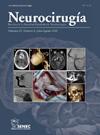成人创伤患者颈椎骨折用晕支具治疗的死亡率危险因素
IF 0.8
4区 医学
Q4 NEUROSCIENCES
引用次数: 0
摘要
halo牙套用于治疗上颈椎骨折,是最刚性的外固定形式。最近,由于已知的并发症和手术稳定的进展,光环牙套已经失去了青睐。本研究旨在确定当前使用晕轮支架的发生率,并确定与创伤患者接受晕轮支架治疗颈椎骨折死亡率相关的危险因素。材料和方法查询2017-2019年创伤质量改善计划数据库中≥18岁颈椎骨折行晕轮支具的患者。排除有穿透性创伤和严重躯干损伤的患者(腹部或胸部的简略损伤量表>;3)。进行了双变量和多变量logistic回归分析。结果144434例颈椎骨折患者中,272例(0.2%)采用了晕支具,其中14例(5%)死亡。死亡的患者年龄较大(73.5岁vs. 53岁,p = 0.011),高血压(78.6% vs. 33.1%, p <; 0.001)和慢性肾病(14.3% vs. 1.2%, p <; 0.001)的发病率较高。格拉斯哥昏迷评分≤8 (46.2% vs. 8.2%, p <; 0.001)和颈脊髓损伤(71.4% vs. 21.3%, p <; 0.001)在死亡患者中更为常见。此外,死亡患者更常出现呼吸系统并发症(7.1% vs. 0.4%, p = 0.004)和脓毒症(7.1% vs. 0.4%, p = 0.004)。在多变量logistic回归分析中,只有格拉斯哥昏迷量表≤8 (OR 19.77, 3.04-128.45, p = 0.002)与死亡率增加相关。结论颈晕支具治疗颈椎骨折患者死亡率仅为5%。呼吸道并发症和败血症在死亡患者中更为常见。在多变量分析中,只有格拉斯哥昏迷评分≤8仍然是死亡率的独立相关危险因素。本文章由计算机程序翻译,如有差异,请以英文原文为准。
Mortality risk factors for adult trauma patients treated with halo brace for cervical spine fracture
Introduction and objectives
Halo braces treat upper cervical spine fractures and serve as the most rigid form of external immobilization. Recently, halo braces have lost favor due to known complications and advances in surgical stabilization. This study aims to determine the contemporary incidence for use of halo braces and identify risk factors associated with mortality in trauma patients undergoing halo brace for cervical spine fractures.
Materials and methods
The 2017–2019 Trauma Quality Improvement Program Database was queried for patients ≥18 years-old with a cervical spine fracture undergoing halo brace. Patients sustaining penetrating trauma and severe torso injuries (abbreviated injury scale >3 for the abdomen or thorax) were excluded. Bivariate and multivariable logistic regression analyses were performed.
Results
From 144,434 patients with a cervical spine fracture, 272 (0.2%) underwent halo brace and 14 (5%) of these died. Those who died were older (73.5 vs. 53 years-old, p = 0.011) and had higher rates of hypertension (78.6% vs 33.1%, p < 0.001) and chronic kidney disease (14.3% vs. 1.2%, p < 0.001). Glasgow Coma Scale ≤8 (46.2% vs. 8.2%, p < 0.001) and cervical spinal cord injury (71.4% vs. 21.3%, p < 0.001) were more common in patients who died. In addition, those who died more often sustained respiratory complications (7.1% vs. 0.4%, p = 0.004) and sepsis (7.1% vs. 0.4%, p = 0.004). On multivariable logistic regression analysis, only Glasgow Coma Scale ≤8 (OR 19.77, 3.04–128.45, p = 0.002) was associated with increased mortality.
Conclusions
Only 5% of cervical spine fracture patients undergoing halo brace died. Respiratory complications and sepsis were more common in those who died. On multivariable analysis only Glasgow Coma Scale ≤8 remained an independent associated risk factor for mortality.
求助全文
通过发布文献求助,成功后即可免费获取论文全文。
去求助
来源期刊

Neurocirugia
医学-神经科学
CiteScore
1.30
自引率
0.00%
发文量
67
审稿时长
60 days
期刊介绍:
Neurocirugía is the official Journal of the Spanish Society of Neurosurgery (SENEC). It is published every 2 months (6 issues per year). Neurocirugía will consider for publication, original clinical and experimental scientific works associated with neurosurgery and other related neurological sciences.
All manuscripts are submitted for review by experts in the field (peer review) and are carried out anonymously (double blind). The Journal accepts works written in Spanish or English.
 求助内容:
求助内容: 应助结果提醒方式:
应助结果提醒方式:


